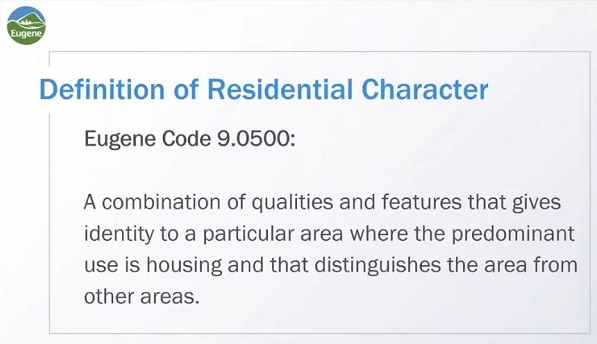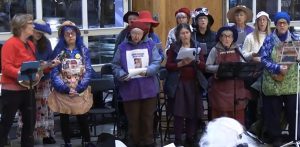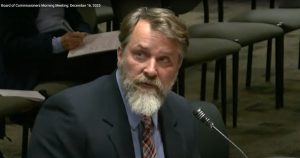Eugene planners: We need to talk about ‘aging’ refinement plans
6 min read
Presenter: Goodbye Jane Jacobs, and hello Robert Moses. The city of Eugene says it has no time for local neighborhood refinement plans, as it embraces top-down state mandates. Speaking to the City Council June 25, Eugene Planning Director Alissa Hunter:
Alissa Hunter (Eugene, planning director): In 2008, Council passed a motion that applied the Eugene Code definition of ‘residential character’ to a specific refinement plan; Council’s interest in this topic surfaced in 2022, during the clear and objective approval criteria; and Council passed a motion to have a further discussion about extending that codified definition to other refinement plans.
[00:00:40] Presenter: That meeting would be held two and a half years later, on June 25, 2025. Alissa Hunter:
[00:00:47] Alissa Hunter (Eugene, planning director): What is the codified definition of residential character? It’s ‘a combination of qualities and features that gives identity to a particular area where the predominant use is housing, and that distinguishes the area from other areas.’
[00:01:02] What are the impacts of this definition if we extended it broader? There are four main themes that I want to just speak to you about today.
[00:01:11] And the first is really, Eugene has an immense need for housing—over 26,000 new homes in the next 20 years. Planning staff, Community Development staff, Public Works staff are really focused on housing actions and productions to increase the housing supply in Eugene.
[00:01:30] One concern: It could make it harder to address our housing need by potentially precluding changes that would allow for newer innovative housing types.
[00:01:40] The second impact is really regarding outcome. The definition is not a clear or effective tool for ensuring good urban design. Rather, it might prevent or delay housing types or developments that the community really needs and wants.
[00:01:56] And then third, extending this definition broader, it would require amendments to these refinement plans. And in some cases, that would require county participation in both the Planning Commission and the City Council process.
[00:02:09] So given staff’s current focus on housing supply and production and, honestly, the massive amount of work, ambitious amount of work ahead of us, much of which is legally mandated, it’s not clear how we would resource this.
[00:02:24] And then finally, the refinement plans are aging. The five that contain the term ‘residential character’ in their policies are between 33 and 43 years old, and in many cases, no longer reflect current context for housing. They’re somewhat of a different era.
[00:02:42] If you think back to 1982, for anybody who was here, the landscape was really different. We had a newly-adopted urban growth boundary that we shared with Springfield. We had an abundant land supply. We had a population of about 104,000 and it was actually shrinking at that time. Very different economic landscape.
[00:03:02] In terms of demographics, over half of Eugene’s current population wasn’t actually born yet. We had definitely lower levels of homelessness. Affordability was, I don’t even know if it was mentioned. I’m sure it was, it was just of a different level.
[00:03:18] Some of the policies in these plans don’t reflect our current housing needs or the natural evolution of neighborhoods. I realize this is a big question for another day, but at some point we will need to discuss what to do with these plans, given their static nature in our ever-changing landscape, and that in some cases, they can be a barrier to housing production and supply.
[00:03:43] Presenter: Councilor Randy Groves:
[00:03:45] Councilor Randy Groves: I’m still a little bit confused. We’re talking about erosion of neighborhood quality. Many in our community would say House Bill 2001 and CFEC (Climate Friendly and Equitable Communities) are doing just that. So how do we bring those two together in a cogent manner that makes sense and still stays within the requirements of the law?
[00:04:07] Alissa Hunter (Eugene, planning director): I don’t think this definition is going to help you get where you want to go with that…
[00:04:12] We are really limited by the state. A lot of that was dictated to us, honestly, by state law. And so in that case, there was not a ton that we could do and adding this definition broader is not something that was going to help with that.
[00:04:29] Councilor Randy Groves: I can appreciate that. I’m thinking also about off-street parking requirements that have gone by the wayside. Basically what I’m looking for is: What is a reasonable response when somebody asks that question, where we don’t sound like a bunch of idiots?
[00:04:46] Alissa Hunter (Eugene, planning director): Which question exactly?
[00:04:49] Councilor Randy Groves: Neighborhood quality.
[00:04:50] Alissa Hunter (Eugene, planning director): Neighborhood quality. I mean, I think it depends on what you mean by neighborhood quality. If you’re talking about sidewalk widths, we have street design standards. If we’re talking about street trees, or are you talking about how the buildings interface with the street? Are you talking about density?
[00:05:07] I mean, there are a number of different tools to get at it. So it kind of, you know, I hate to use this planner answer, but: It depends. It depends what we’re talking about. I can tell you in all of those cases, adding this definition isn’t going to address those things.
[00:05:23] Let’s look at our development standards. Let’s look at street design standards and projects that are working on the street. Those are places that the tools make more sense to address those things.
[00:05:37] Presenter: Councilor Groves:
[00:05:38] Councilor Randy Groves: I’m not sure that’s going to satisfy some parts of our community, and that’s what I’m looking for, a cogent response that I can give them.
I mean, I’m thinking also about off-street parking requirements that have gone by the wayside, just even taking the narrow scope of off-street parking, married with skinnier streets that only allow parking on one side of the street.
[00:06:01] It just seems like we’ve got a lot of things that are working contrary to each other and some of the goals and objectives that we’ve set as a council, but also has been foisted upon us by changes in state law.
[00:06:14] I don’t know that there is a response that’s going to make sense but it’s always frustrating to me when I try to explain something and I can just see people getting more and more confused and I think that’s what’s going to happen here.
[00:06:28] Presenter: Councilor Eliza Kashinsky:
[00:06:30] Councilor Eliza Kashinsky: I feel like this language is very subjective, it really is. How someone would define the unique qualities that make a neighborhood unique is very different for people within that neighborhood.
[00:06:48] And I know for a fact that some of the arguments that have been put forward as to what makes my neighborhood unique are the polar opposite of what I think makes my neighborhood unique.
[00:06:59] And I know that the intent of this was to prevent incompatible infill, which, again: What is compatible and incompatible is different for different people. And so I see this policy and this attempt to broaden this definition to more areas of the city as an explicit attempt to put in place barriers to housing. Like, that is the intent of this, is to put in place barriers to housing in our neighborhoods and I’m not in favor of that. I think we need to be working very hard to remove barriers.
[00:07:32] Presenter: Councilor Jennifer Yeh:
[00:07:34] Councilor Jennifer Yeh (June 25, 2025): In November of ‘22, I voted against this and I would not support this now. I think this term is a relic of a time when folks were looking, many people in power were looking for ways to exclude certain housing types and certain people from their neighborhoods. And this was a tool that they used to do that, that is not something we want to currently do.
[00:07:55] And in many cases, it’s not even effective. We have much better ways to do the things that we want to do in our community, and we don’t need to keep these relics of a time of exclusion in our code. I would not be in favor of putting it in other places as I was not in favor of keeping it in the first one.
[00:08:15] So if we have specific things that we want to talk about, that we want to try to do in our community, let’s do that. Let’s not keep these vague, in my mind, discriminatory terms in our land use. So let’s move on and be more effective in better ways.
[00:08:33] Presenter: Two and a half years after the city council asked for a work session to consider adding the term ‘residential character’ to all of the refinement plans, Planning staff suggests it might be time to talk about what to do with the ‘aging’ refinement plans, which they say are from another era.





